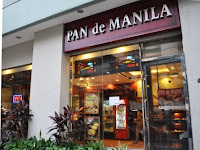 |
| salad greens with all the trimmings at Sonya's Garden in Tagaytay |
 |
| turon, sweet potato bits, and chocolate cake |
 |
| sinigang sinangag at top and crispy dinuguan in the middle |
The road from Tagaytay to Makati led us to a local chain of restaurants called Kanin Club where rice (kanin) is served in utterly unique ways. A favorite is sinigang sinangag, an oxymoron. The first word means sour soup and the second means fried with lots of garlic; in other words, fried soup! The rice is first boiled with sour soup and then fried so the rice tastes like the soup with all its condiments. They also had crispy dinuguan which literally means bloodied. It is usually pork sautéed in garlic and onions then stewed with pork blood, vinegar and chilis. Their version used chicharons or crispy pork cracklings!
 |
| chicken binacol |
Then a reunion with friends at a local hotel chain, Legend Villas, was a feast of Filipino dishes, laid out on a sumptuous buffet table. I stuffed myself with chicken binacol, a legendary thin soup made from chicken, pepper leaves, green papaya, garlic, onion, and lots of ginger and pepper! But, I tried to leave room for the other dishes I have long waited for (my cooking does not approximate the real thing!). I feasted on Spanish kare-kare: meat with a thick sauce of ground peanuts and toasted rice and lots green beans, bokchoy, eggplant and banana hearts.
 |
| Halo-Halo Bar |
Vegetable ukoy, pork barbecue, beef salpicado, poached fish, Filipino salad, etc. were also there but I wanted to save space for dessert which was a complete Halo-Halo (literally, mix-mix) bar. No one visiting the Philippines should miss this. Back in the US we even bought an ice shaver and ingredients for Bill! A bowl of beans in syrup, caramelized sweet potato and banana cubes, cubes of coconut gel and gelatin, and toasted puffed rice are topped with shaved ice and milk. Then we add special toppings of leche flan (egg custard), sweet purple yam, and even ice cream!
 |
| street kiosk among office buildings |
 |
| Salcedo Saturday food market |
Contrast these to $1 a dish street food available at sidewalk kiosks along the busy streets where blue-collar workers queue for quick lunches and a Saturday market at the Salcedo Park in the middle of high-rise condos where local (and international) cuisine can be had for a song on Saturdays courtesy of enterprising residents. But I should mention the large selection of seasonal tropical fruits I have missed most: mabolo, chesa, makopa, kaimito, chico, santol, duhat, sinigwelas, mangoes, papayas, pineapple, star apple, coconuts, durian, guayabano, and many varieties of bananas.
 |
| coconuts, durian, and guayabano |
I do not know why Filipino food has not become famous. Could it be that Filipinos are just not more entrepreneurial rather than the cuisine being too bland? Here’s what Bill, my Caucasian husband and guest blogger, says: ‘I must admit that many of the fruits that Carol mentioned are not as appealing to me as a good orange, peach, nectarine, or apple. However the mangoes are better than those usually available in the states, but I find little difference in the pineapples, bananas, papayas. But you should all have some of the Taiwanese mangoes which taste just as good as Philippine mangoes but are at least as big as big papayas!
 |
| kaimitos, mangoes, chesas, santols chicos, macopas, and guavas |
Perhaps the best reason that Filipino food hasn’t taken off in the US is the fact that the business aspects of the product/market mix have not been explored enough. Most appeal to a Filipino niche looking for their comfort food. Even if I have acquired the taste for them, most Americans would not like them. Marketing and presentation are critical. Just as many Mexican restaurants have become “gringo-ized”, Filipino restaurants would need to modify (Americanize) in order to become truly established in the US.
 |
| 24x7 hot pan de sal |
Besides, Fiiipinos easily fit into the American scene, because of language and the long exposure to Americans. It also seems that they all like to cook! Whenever there is a gathering there is food, lots of food, so why go to restaurants? But those Spanish-influenced dishes like salpicado, mechado, caldereta, cocido, and afritada are similar to our pot roasts and beef stew (with slightly different flavors) so they can become favorites, along with the standard adobo (meat stewed in soy sauce, vinegar, garlic, onions, and bay leaves) and pancit (rice noodles, chicken, and vegetables ).
So, I also feasted on Filipino Food, including the ubiquitous pan de sal (sweet dinner rolls, mainstay of Filipino breakfasts and snacks) sold freshly baked at ubiquitous Pan de Manila shops 24x7!
So, I also feasted on Filipino Food, including the ubiquitous pan de sal (sweet dinner rolls, mainstay of Filipino breakfasts and snacks) sold freshly baked at ubiquitous Pan de Manila shops 24x7!
looks like some good food! I also think I saw a chocolate cake, which is VERY acceptable to the American palate.
ReplyDeleteSoo, are you two gaining weight??
Yes, yes, yes! We are gaining weight! Thanks for your visit.
ReplyDeleteOkidoki! Was that a direct translation? Russian?
ReplyDeleteCarol
A family member referred me to this site. Thanks
ReplyDeletefor the information.
Also visit my page ... tender writing sunshine coast
It looks almost too good to eat! It's a visual feast because to the brilliant colors and fresh ingredients, and I can only imagine how good the flavors will taste. Without a doubt, I'll bookmark this recipe and attempt it this coming weekend. I appreciate you sharing this amazing idea. Additionally, you ought to eat Vegan Food and Vegan Products which are tasty and healthy.
ReplyDelete